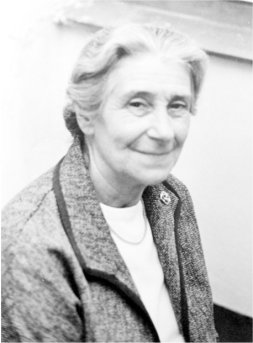
Berta Karlik (1904-1990). When you think of female scientists and early research on radioactivity, you probably think of Marie Curie – but there were others, including one whom I’d never heard of – Berta Karlik, an Austrian physicist who co-discovered the 85th element – astatine – and was the first female professor at the University of Vienna.
Karlik was born January 24, 1904 in Vienna, Austria. She bucked the norms for a woman at the time and studied math & physics at Vienna University, graduating with honors and earning a scholarship from the International Federation of University Women to study abroad – she performed research at London’s Royal Institution, receiving training from Sir William Bragg, and Paris’ Curie Institute, where she worked with fellow pioneering women including Eva Remstedt and Lise Meitner.
She then returned to Vienna and began working at the Institute for Radium Research, first as a scientific assistant but then rising through the ranks, becoming director of the Institute after WWII and becoming a full professor at the University of Vienna in 1956.
While at the Institute for Radium Research, she and her colleague Traude Bernert discovered naturally-occurring astatine. If you’re gonna discover an element, astatine is a pretty cool one to find – it even has cancer-fighting potential. But it sure is hard to find! It’s the rarest naturally occurring element because it’s really unstable – it’s radioactive and has a really short half-life, meaning that if you leave it be it’ll quickly “break,” giving off radiation and becoming a different element.
Karlik & Bernert discovered the first naturally-occurring astatine (they were studying another radioactive element that decayed into it), but other researchers found their way to it synthetically. A group of scientists working independently at the University of California, Berkeley was able to create astatine “unnaturally” by bombarding atoms of the element bismuth with alpha particles (a type of radiation).
Karlik and Bernert’s discovery was underacknowledged because it was conducted during WWII under German occupation and communication was difficult. And while astatine is what Karlik’s best known for when people do know about her, it’s not all she contributed to science. She also studied radiation therapy and, while at the Royal Institution, she developed crystallographic methods for studying hydrocarbons and co-wrote a book on crystallography data tables.
Karlik was inducted into the Academy of Sciences in 1973 and became its first female full member. Other honors include the Austrian Academy of Sciences’ Haitinger Prize and the Prize of the City of Vienna. She was a founding member of the Austrian Physical Society and a member of the planning staff of CERN, and she advised the government about the peaceful use of atomic energy and helped found the International Atomic Energy Commission.
